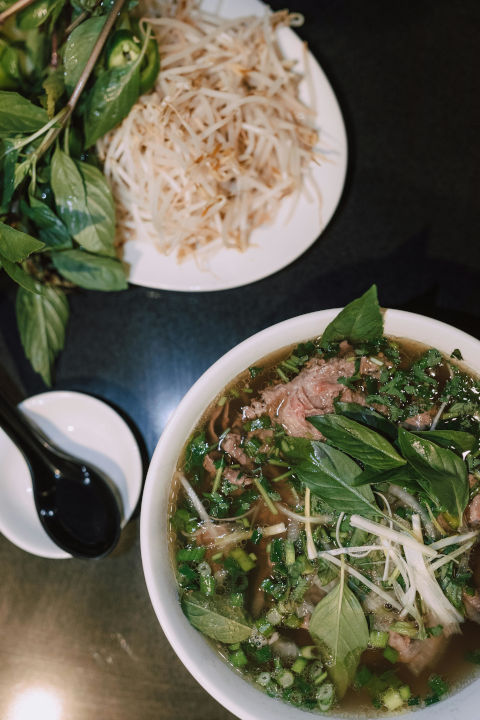The period of French colonization in Vietnam, which lasted from 1887 to 1954, left a lasting imprint on Vietnamese culture, especially in its gastronomy.
This integration was manifested through the introduction of new ingredients such as European vegetables, beef, and coffee culture, which deeply enriched Vietnamese cuisine.
This fusion of French and Vietnamese flavors gave rise to a unique culinary palette, where traditional French dishes were often reinterpreted with Vietnamese techniques and ingredients.
In this article, L’Atelier An Phu tells you more about 4 iconic Vietnamese dishes inspired by French cuisine.
Table of Contents
Toggle1. Bánh mì

The Bánh mì, a crispy baguette filled with meat, vegetables, and sauce, is a symbol of French influence in Vietnam. Its introduction dates back to the early 20th century when the French brought the baguette to Vietnam. The local population quickly embraced this ingredient, filling it with meat and vegetables according to their own tastes.
Ingredients:
- French baguette
- Meat (pork, chicken, or beef)
- Vegetables (carrots, cucumber, coriander)
- Sauce (mayonnaise, soy sauce, chili paste)
Instructions:
- Cut the baguette in half lengthwise.
- Fill the inside with grilled meat and vegetables.
- Add sauce to taste.
- Close the baguette and enjoy!
2. Phở

Phở, the national soup of Vietnam, beautifully embodies the French-Vietnamese culinary fusion, carrying in its fragrant broth the traces of a rich and complex history. Its origins remain obscure, but it is said that in the early 20th century, in the northern province of Nam Dinh, not far from Hanoi, this iconic dish emerged.
This region, a hub of intense manufacturing activity, was a melting pot where Vietnamese textile workers, soldiers, and French colonists mingled. It was this cultural melting pot that gave birth to Phở.
The broth, infused with the characteristic flavors of the northern region, enhanced by nuoc-mâm, a condiment made from fermented fish, welcomes rice noodles and local spices such as coriander, cinnamon, star anise, and kaffir lime leaves. To this Asian base is added the French touch with the addition of beef, reminiscent of our pot-au-feu and even justifying the origin of the name “Phở”, likely derived from “feu” (fire).
Ingredients for the broth:
- Beef bones
- Ginger, onion, cloves, cinnamon, star anise
- Salt, sugar
- Rice noodles
- Beef (thinly sliced)
- Garnishes (fresh herbs, bean sprouts, chilies, lime, hoisin sauce)
Instructions:
- Grill the ginger and onion.
- Add the spices to a pot with the beef bones and boil for at least 1 hour.
- Cook the rice noodles according to package instructions.
- Arrange thinly sliced beef on the cooked noodles.
- Pour hot broth over the beef and noodles.
- Serve with garnishes to taste.
3. Bò kho

Bò kho, meaning “stewed beef,” is a spicy beef stew with vegetables and spices, usually served with rice or bread. The origin of Bò kho is uncertain, but it is generally considered a dish from southern Vietnam. Some believe it was born from French influence, mixed with Chinese influences, during colonization, as it bears strong similarities to beef bourguignon.
Ingredients:
- Beef (cut into pieces)
- Carrots, onions, potatoes (diced)
- Crushed tomatoes
- Spices (cinnamon, cloves, star anise)
- Soy sauce, salt, pepper
Instructions:
- Sauté the onions in a little oil until golden.
- Add the beef and lightly brown.
- Incorporate the vegetables and crushed tomatoes.
- Season with spices, soy sauce, salt, and pepper.
- Add water to cover everything and simmer over low heat until the beef is tender.
4. Caramel aux œufs (Kem caramel)

Caramel aux œufs, known as “Kem caramel” in Vietnamese, is a popular dessert worldwide. Its Vietnamese version is distinguished by its creamy texture and slightly caramelized taste, a result of an adaptation of the original French recipe.
Ingredients:
- Eggs
- Sweetened condensed milk
- Coconut milk
- Sugar
Instructions:
- In a saucepan, melt the sugar over low heat until golden caramel.
- Pour the caramel into ramekins.
- In a bowl, beat the eggs, sweetened condensed milk, and coconut milk.
- Pour the mixture into the ramekins.
- Bake in a water bath in the oven until the caramel sets.
Conclusion
Through these culinary delights, we witness a harmonious fusion of flavors, techniques, and ingredients, reflecting the history and exchanges between Vietnam and France. Each dish is a celebration of this unique relationship, capturing the very essence of cuisine as a cultural expression.
L’Atelier An Phu, through its French courses, invites you to delve even deeper into French culture. Join us now at our Thao Dien school in Saigon to quench your thirst for knowledge!






